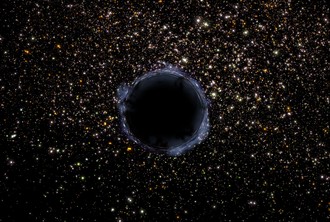
In a recently published paper entitled, “MOCCA code for star cluster simulations - IV. A new scenario for intermediate mass black hole formation in globular clusters”, Mirek Giersz from NCAC and his collaborators discuss a new scenario for the formation of an intermediate-mass black holes (IMBHs) in globular clusters (GCs). The existence of IMBHs is an active topic of research that has been the subject of considerable debate. The discovery of this elusive population of black holes (BHs) will not only account for the missing link between stellar mass and supermassive BHs but will also be a major advancement in our understanding of the formation of massive BHs and their relation to galaxy formation. GCs are dense stellar systems that can contain up to a million stars. It has been suggested that these dense clusters of stars may harbour an IMBH.
While analysing results from over 400 simulations of different star cluster models that were simulated using the MOCCA code (MOnte Carlo Cluster simulAtor) for star cluster evolution (one of the most advanced codes for stellar dynamics developed from scratch at Nicolaus Copernicus Center (NCAC), Giersz and his collaborators discovered that an IMBH was forming in some of these models. A more detailed analysis of these models showed that the IMBHs formed via dynamical interactions of hard binaries containing a stellar-mass BH with other stars and binaries. The published results discuss the necessary conditions to initiate the process of IMBH formation and the influence of an IMBH on the host global GC properties. This new scenario for IMBH formation does not require any special specific conditions and IMBHs form solely through dynamical interactions and mass transfer in binaries, with the latter playing an especially important role by inducing collisions. There are two different regimes which result in the build-up of BH mass in this new scenario. In the first regime, the BH mass builds up slowly during the late cluster evolution and has a small mass accretion rate (SLOW scenario). In the second regime, the build-up of the BH mass starts very early during the cluster evolution and has an extremely high mass build-up rate (FAST scenario). Results show that the formation of an IMBH is a highly stochastic process, generally, the formation probability of an IMBH is higher when the cluster is more concentrated (has higher central densities).
The authors also use their simulation results to discuss the observational signatures associated with the presence of an IMBH in GCs. These include the spatial and kinematic structure of the host cluster, possible radio, X-ray and gravitational wave emissions due to dynamical collisions or mass transfer and the creation of hyper-velocity main-sequence escapers during strong dynamical interactions between binaries and an IMBH. The authors also provide examples of Galactic GCs that have similar properties to the present-day properties of simulated models that feature the formation of an IMBH.
Authors: Mirek Giersz (NCAC), Nathan Leigh (University of Alberta and American Museum of Natural History), Arkadiusz Hypki (NCAC and Leiden University), Nora Lützgendorf (ESA, Space Science Department) and Abbas Askar (NCAC).
Picture: Artist's View of a Black Hole in a Globular Cluster - Credit: NASA/ESA and G. Bacon (STScI)






